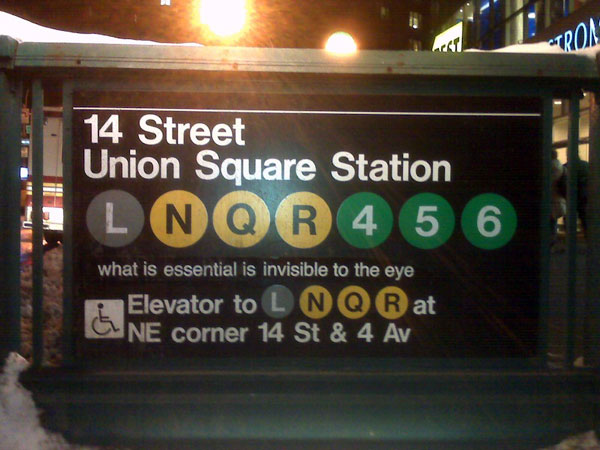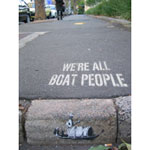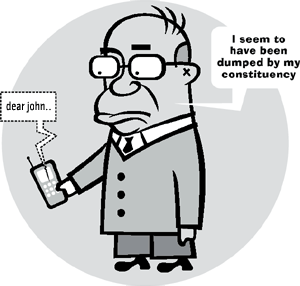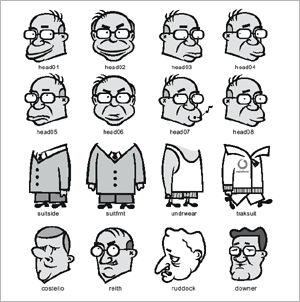stickers
What is Essential
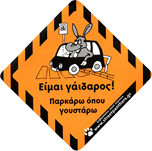 “In the last year alone, the most innovative display of activism has sprung from the Streetpanthers, a band of thirtysomethings who under cover of night prowl the streets of Athens slapping the vehicles of egregious parking violators with Day-Glo orange stickers depicting a donkey in a car above the message, ‘I park wherever I want.’ More than 250,000 stickers have been distributed nationwide since the group’s Web site began operation (www.streetpanthers.gr) in July.”
“In the last year alone, the most innovative display of activism has sprung from the Streetpanthers, a band of thirtysomethings who under cover of night prowl the streets of Athens slapping the vehicles of egregious parking violators with Day-Glo orange stickers depicting a donkey in a car above the message, ‘I park wherever I want.’ More than 250,000 stickers have been distributed nationwide since the group’s Web site began operation (www.streetpanthers.gr) in July.”
Beware of the God
Like the U.S., Australia has a growing problem of fundamentalists in politics.
In response, graphic designer, artist, and activist Deborah Kelly has undertaken a large scale public art project in the streets (skies and train stations) of Sydney. From bewareofthegod.com:
“This site intends to be a resource of diverse material documenting, analyzing, and musing upon the impacts and aspirations of religious literalists in the public sphere. It is being produced in Australia, in 2005, so that is its first focus. However, you will also find here information, ideas and reportage from other places, because even though context is everything, a global phenomenon is also something.”
The project incorporates multiple media, including:
A 30 second film shown every ten minutes on 42 billboard screens in Sydney train stations, viewable in miniature here [Quicktime 874 Kb]
Projections onto clouds over Sydney Harbor:
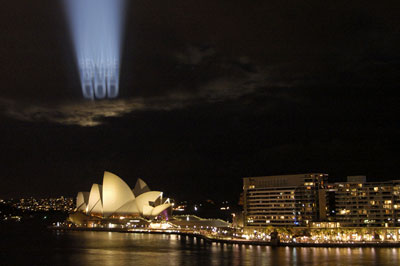
Distribution of 40,000 free postcard/stickers (you can mail or peel the front off and stick to your door.)

And essays and analysis posted on the project Web site. On the site is an open call for further cultural and analytical material.
The effort is backed by the Museum of Contemporary Art in Sydney as part of their biennial Contemporary Australian Art show, this year called Interesting Times.
Related projects from Kelly include a series of posters designed with Tina Fiveash satirizing the right wing regime of “compulsory heterosexuality”.

And a series of illustrated matchboxes satirizing the Christian right push in Australia to have muslim women and girls banned from wearing hijab “because they might be hiding bombs.” Kelly and friends made thousands of satirical matchboxes and left them lying around.

Kelly is also involved in a collective challenging the rhetoric of politicians calling refugees ‘boat people.’ See more at http://www.boat-people.org/
Though not aligned with a specific organizing campaign, I think such cultural work is important in the battle for hearts and minds.
Texting for Change
Is it still news that grassroots protest movements are using electronic media to facillitate political change? Here are two stories from the same week.
Ecuadoreans rebelled by radio, e-mail and text, Reuters, April, 23, 2005:
“Fed up with politicians, Ecuadoreans turned to local radio, text messages and the Internet to whip up a street rebellion this week that helped push their president Lucio Gutierrez out of office.
Gutierrez, a former army officer elected in late 2002, was waiting in Quito’s Brazilian embassy residence on Saturday for safe conduct to asylum in Brazil, three days after intense protests played their part in forcing him from office.
Buoyant protesters, including businessmen, housewives and students, described the demonstrations as a popular rebellion that grew through word of mouth, cellular telephone text messages and broadcasts on La Luna, a local radio station.
Many said the week-long rallies were a spontaneous reaction to frustration with what they saw as the government’s abuse of power and disappointment with leaders of all political colours....
Quito protesters took their name — the Forajidos, or the outlaws in Spanish — from criticism Gutierrez fired at them when demonstrators rallied outside his family home.
 Car windshield stickers and T-shirts carrying the logo soon appeared on Quito’s streets.
Car windshield stickers and T-shirts carrying the logo soon appeared on Quito’s streets.
When momentum started to build last week, La Luna began broadcasts calling for peaceful pan-banging demonstrations, protests with balloons and even demonstrations by lobbing rolls of paper towels.
One distributed e-mail showed an animated image of pots banging on the screen.
La Luna, a small independent Quito FM radio station that has a history of questioning the government, was key in mobilizing the rallies.
‘People came here to denounce things. When it started to get big the politicians turned up, but the people just shouted at them to get out,’ Tobar said.
As protests grew the Gutierrez government blocked La Luna’s signal, Tobar said, a charge the former government dismissed. Demonstrators began sending text messages with details of rallies when La Luna went briefly off the air.
Outside the Brazilian embassy residence, protesters have rallied for three days to demand their new government stop Gutierrez leaving the country. Many want to see him jailed.
La Luna blasted this week from the radio of a car parked outside the residence, keeping protesters up to date on new developments.
Gutierrez, who was jailed before for leading a coup, came to office with the popular support of the poor and Indian groups after promising populist reforms. But many said they felt betrayed by his tough economic policies.
The former government blamed Radio La Luna for fomenting violent protests on the streets and threatened legal action. But the radio station insists on its independence though manager Tobar acknowledged its open opposition to Gutierrez.”
Note the emphasis on a strong brand here, too.
Chinese cellphones fuel protest, NY Times, April 24, 2005:
“The thousands of people who poured onto the streets of China this month for the anti-Japanese protests that shook Asia were bound by nationalist anger but also by a more mundane fact: they are China’s cellphone and computer generation.
For several weeks as the protests grew larger and more unruly, China banned almost all coverage in the state media. It hardly mattered. An underground conversation was raging via e-mail, text message and instant online messaging that inflamed public opinion and served as an organizing tool for protesters.
The underground noise grew so loud that last Friday the Chinese government moved to silence it by banning the use of text messages or e-mail to organize protests. It was part of a broader curb on the anti-Japanese movement but it also seemed the Communist Party had self-interest in mind....
‘Chain letter’ e-mail and text messages urged people to boycott Japanese products or sign online petitions opposing Japanese ascension to the United Nations Security Council. Information about protests, including marching routes, was posted online or forwarded by e-mail. Banned video footage of protest violence in Shanghai could be downloaded off the Internet.
‘Text messages, instant messaging and Internet bulletin boards have been the main channels for discussing this issue,’ said Fang Xingdong, chairman of blogchina.com, a Web site for China’s growing community of bloggers. ‘Ten years ago, this would have been unthinkable.’
In Shanghai, the local police even sent out a mass text message to cellphone users the day before that city’s raucous protest. ‘We ask people to express your patriotic passion through the right channel, following the laws and maintaining order,’ the message said. Some marchers saw the message as a signal to proceed, while others took it as a warning.
In early 2003, text messaging and the Internet played a major role in helping people pass reliable information - and also unfounded rumors - about the outbreak of SARS at a time when the government was covering up the disease.
In the anti-Japan protests, people have sent old-fashioned chain letters to friends via e-mail or text message. Typical is a 23-year-old professional in Shanghai who asked to be identified for this article by her English name, Violet. She uses an instant messaging service on her work computer to communicate with 50 people on her ‘contact list.’...
About 27 percent of China’s 1.3 billion people own a cellphone, a rate that is far higher in big cities, particularly among the young. Indeed, for upwardly mobile young urbanites, cellphones and the Internet are the primary means of communication.
‘If people can mobilize in cyberspace in such a short time on this subject," said Wenran Jiang, a scholar with a specialty in China-Japan relations, "what prevents them from being mobilized on another topic, any topic, in the near future?’”
The protests eventually wrung an apology from the Prime Minister of Japan.
Oddly, while the China story made the NY Times. The Ecuador story was hardly picked up at all — and has disappeared from the swissinfo site where I first caught it. Is independent radio in Latin America not as “sexy” as cellphones in China?
War is Not Healthy
 In 1965, Lorraine Schneider, an activist and mother, created the original art for “War is Not Healthy.” She entered the 4" by 4" print into a design contest. Her image was seen as too simplistic and did not win.
In 1965, Lorraine Schneider, an activist and mother, created the original art for “War is Not Healthy.” She entered the 4" by 4" print into a design contest. Her image was seen as too simplistic and did not win.
In an introduction to a book of Schneider’s art work, Barbara Avedon wrote:
“On February 8, 1967, fifteen friends met at our house to discuss ‘doing something’ about the war in Vietnam. We wanted to do something that would communicate our horror and disgust to our elected representatives in one concerted action. We were not ‘bearded sandaled youths,’ ‘wild-eyed radicals’ or dyed in the wool ‘old line freedom fighters’ and we wanted the Congress to know that they were dealing with an awakening and enraged middle class — voters, precinct workers, contributors. We decided to send a Mother’s Day card to Washington. We would print and distribute one thousand — one thousand letters of protest that said in a very ladylike fashion:
For my Mother’s Day gift of this year,
I don’t want candy or flowers.
I want an end to killing.
We who have given life
must be dedicated to preserving it.
Please talk peace.
Lorraine had given our family an etching of ‘Primer’ some months prior to that meeting. Its eloquent, irrefutable, sunflower truth said it all for us. I called Lorraine and asked if we could use ‘Primer’ on the face of the card. She said, yes, and one thousand became two hundred thousand cards. And because of her genius Another Mother for Peace was born.” [source]
Another Mother for Peace was founded to “educate women to take an active role in eliminating war as a means of solving disputes between nations, people and ideologies.”
The overwhelming success of the Mother’s Day card led to the creation of the AMP newsletter, filled with anti-war editorial and reports on the stances of lawmakers on issues related to war and peace. Each newsletter contained a number of action items called ‘Peace Homework’ that encouraged readers to make their voices heard by organizing, educating and communicating with other citizens and their elected representatives.
Thirty-six years later, concerned about the human costs of America’s “war on terror” Joshua Avedon, Barbara Avedon’s son, and Carol Schneider, Lorraine Schneider’s daughter, began to consider — separately — how to revive AMP.
Schneider’s image has become an international icon for the anti-war movement. Supporters of Another Mother for Peace display the image around the world. A simple yet powerful statement of conscience, the sunflower logo helped make Another Mother for Peace a visible anti-war voice.
In cooperation with Another Mother for Peace, the Center for the Study of Political Graphics has reproduced the War is Not Healthy poster, the first edition available since the Viet Nam War. Stickers, pins, and other materials are avaialble from Another Mother for Peace.
Dear John...
A collective of communication designers in Melbourne, Australia are working to defeat the current conservative government of Prime Minister John Howard.
The site dearjohn.org targets the youth vote, inviting them to download free T-shirt transfers, screen savers, badges, posters, and stickers.
Although united by a common agenda to defeat Howard, the designers do not highlight a specific issue or push an alternative party to vote for. This is left for the audience to fill in blanks.
Literally. In addition to readymade downloads, the site hosts a variety of do-it-yourself materials, including instructions on making your own collage posters or gaffers tape T-shirts, and downloadable political clipart and “dingbats” — image fragments and caricatures you can use to assemble your political messages and media.


